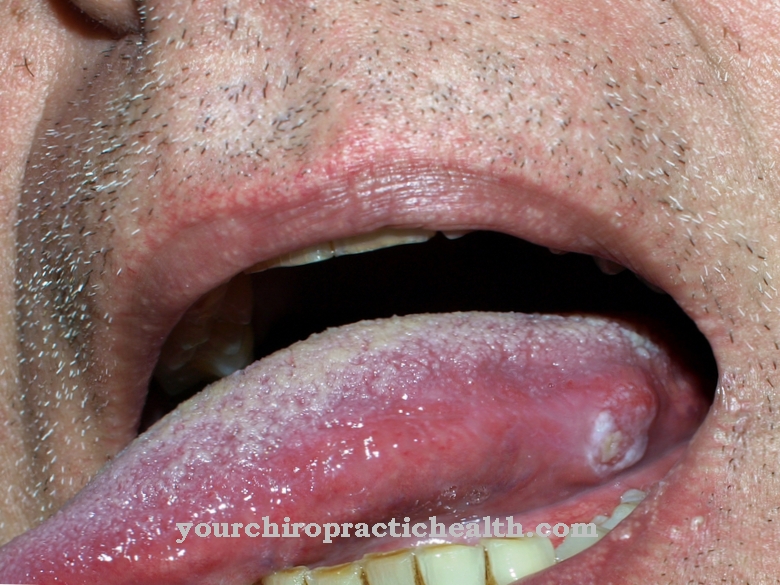Under the term Erythema the dermatologist understands a reddening of the skin caused by increased blood flow to the affected area. The causes are varied and must be clearly identified in order to be able to initiate adequate treatment. The prognosis depends on the underlying disease, but the erythema usually fades on its own after a short time.
What is an erythema?

The word erythema is derived from the ancient Greek term "erýthema", which means something like "redness" or "inflammation". He describes the only symptom of erythema, the reddening of the skin. This can appear in different color intensity, size, extent and strength.
The erythema is one of the so-called primary efflorescences. This is skin reddening and skin changes that result from a pathological process that takes place directly in the skin.
No other diseases affect them. For this reason, primary fluorescences have a high diagnostic value. Other important skin changes in this group are macula, a reddening of the skin caused by pigment disorders, papules and cysts.
causes
The causes of erythema are varied. It is therefore not possible to make general statements.
Basically, however, it can be said that on the one hand erythema can be a normal phenomenon, possible in all people, if it occurs as a flush of shame. Shame redness, which dermatologists call erythema pudoris, is colloquially discussed, for example, with the saying "make someone blush" and is harmless. On the other hand, erythema is an important symptom of many skin diseases. Important examples are disk rose, Stevens-Johnson syndrome and "scalded skin syndrome".
The disk rose mainly affects young people and shows up on the extremities and face. The disc-like, fingernail-sized erythema often occurs together with joint pain, fatigue and a slight fever and heals spontaneously after a while.
Those affected by Stevens-Johnson syndrome also suffer from a seriously disturbed general condition. Symptoms of this disease are erythema, high fever, herpes-like blisters in the mouth and genital area, and conjunctivitis. Steven-Johnson syndrome is often caused by infections that have not healed sufficiently or by allergic reactions.
The "scalded skin syndrome", also known as Lyell's syndrome, is life-threatening because the entire epidermis becomes detached from the body. It then dies and the protective function of the skin is massively disturbed. This condition is caused by severe allergies or side effects of certain drugs.
You can find your medication here
➔ Medicines for skin redness and eczemaSymptoms, ailments & signs
Erythema can cause various symptoms and ailments. The disease manifests itself primarily as a noticeable reddening of the skin, which can be felt in different parts of the body. Most of the time, erythema occurs in areas of the body that are well supplied with blood, for example on the chest, arms or genital area.
An erythema can be recognized by the fact that it changes color when pressed. Usually it does not cause pain itself. However, the causative disease can cause pain and other symptoms in the later stages. Depending on the cause of the erythema, serious symptoms can occur. If the symptoms are caused by bleeding from the skin, itching and pain usually also occur.
If the erythema occurs as a preliminary stage of eczema, further skin changes occur over time, including bleeding and itching of the skin. If left untreated, erythema will grow in size and may spread to the entire arm, chest, or genital area.
In the case of larger erythema, sensory disorders are conceivable. In addition, those affected often feel a feeling of illness, which increases as the reddening of the skin increases. If erythema is treated early, there are usually no other symptoms or discomfort.
diagnosis
The affected person usually notices the reddening of the skin himself and goes to a dermatologist. It is important to describe the observed symptom as precisely as possible when making an appointment so that an urgency classification can be made. Otherwise the patient could wait a long time for an appointment.
The dermatologist should be able to tell at first glance whether there is erythema, skin bleeding or the preliminary stage of eczema. When making a diagnosis, it is helpful to put pressure on the affected area, because if this can be discolored, it is clearly an erythema.
Usually the dermatologist will refer the patient to a general practitioner to initiate the diagnosis and treatment of the underlying disease. Nevertheless, a dermatologist should first be consulted in order to rule out other diseases.
Complications
In the case of erythema, the cause of the complications associated with the reddening of the skin depends on the cause. If the erythema is caused by an infection, dangerous symptoms can develop without treatment. Secondary infections of the affected areas of the skin as well as other organs can develop, which can be life-threatening.
Treatment with antibiotics is indicated for bacterial infection as the cause of the erythema, and erythema caused by fungal infections should also be treated with medication. However, treatment with medication can also lead to complications, as allergic reactions and intolerance are possible. These can also manifest themselves in skin manifestations, in extreme cases a life-threatening allergic shock with circulatory failure can occur.
If an allergic reaction is the reason for the appearance of an erythema, avoiding the triggering substance is usually sufficient in the case of a contact allergy. The reddening of the skin will usually go away on its own without the need for further treatment. However, in the context of allergic reactions, inflammatory changes in the erythema can also occur, which spread to deeper layers of the skin.
Secondary infections are another possible complication here. Likewise, even with adequate treatment, scarring can occur in the affected areas. Fever and a reduced general well-being are also possible complications of inflammatory skin processes.
When should you go to the doctor?
An erythema should be clarified by a doctor as soon as complications arise. Redness on the skin, fever or joint pain always require a medical examination. The same applies to bleeding, itching and other symptoms that affect well-being. An appointment with a general practitioner should be made, especially if the symptoms have not subsided after two to three days at the latest. People who perceive erythema to be a cosmetic blemish are best to speak to a therapist.
In particular, you should speak to a specialist about large-area lesions before you experience psychological disturbances. If inferiority complexes or depression are already noticeable, the following applies: seek psychological advice immediately. The earlier mental illnesses are treated, the less likely the long-term effects are.
After that, people who have a pre-existing condition such as Stevens-Johnson Syndrome or a skin disease should see a doctor with erythema. In general, the erythema indicates a serious illness and therefore needs to be investigated and treated if necessary. In the event of severe complications, it is best to call the emergency medical service.
Doctors & therapists in your area
Treatment & Therapy
Treatment of erythema depends on the underlying disease diagnosed. While some causes, such as disc rose, cannot be treated, other causes can still be treated if diagnosed in good time. The erythema itself cannot be treated.
A special form of erythema is Erythroderma: This occurs when more than 90% of the body is affected. Erythroderma means something like "red skin" in ancient Greek. The skin is severely inflamed and the vessels are dilated. There is a loss of fluid, protein and salt, which can lead to life-threatening secondary infections.
Due to the vasodilation, patients suffer from severe heat loss from the body and thus excessive sensitivity to cold. A first indication of erythroderma is therefore the clothing style of those affected by those affected as always too warm. Like erythema, erythroderma is not an independent disease.
It is a symptom and therefore an important indicator of other diseases and symptoms, such as age, drug intolerance or psoriasis.
Outlook & forecast
Depending on the underlying cause of the erythema, the reddening of the skin can develop differently. If the cause is a harmless inflammation, it usually subsides after a few hours to days. In the case of serious skin diseases, however, the erythema can persist for weeks and months. Patients with a chronic skin disease permanently suffer from skin changes. Nevertheless, the prognosis is usually good - an erythema is usually unproblematic and does not cause any other symptoms besides itching and pain.
In individual cases, erythema can develop into eczema, which can increase in size and cause accompanying symptoms such as fever. In the worst case, eczema can lead to inflammation and thus to sepsis. A spread to the internal organs is also conceivable and associated with a rather poor general prognosis. With early treatment, however, the prospect of a speedy recovery is good.
The dermatologist can prescribe suitable medication and care products with which the skin changes can be reliably treated. Basically, erythema has a good prognosis. If the skin changes are clarified and treated at an early stage, they usually subside or at least do not progress any further.
You can find your medication here
➔ Medicines against skin redness and eczemaAftercare
As a rule, there are hardly any measures or options for follow-up care available to those affected by this disease. The disease must primarily be treated by a doctor so that there are no further complications and complaints. The further course also depends very much on the exact underlying disease that is responsible for the erythema, so that no general prognosis can be made about the further course.
Early detection and subsequent treatment, however, always have a positive effect on the further course of the disease. In most cases, those affected with this disease are dependent on taking medication. These should be taken regularly, paying particular attention to the doctor's instructions.
If you have any questions or are unclear, a doctor should always be contacted first. In many cases, those affected also have to adjust their clothing style, as the disease can also impair the feeling of warmth or cold. A doctor can also help with this. In everyday life, many people affected depend on the help of family and friends, although contact with other people affected can also be useful.
You can do that yourself
If you have erythema, you should definitely see a family doctor or dermatologist. Which measures those affected can take themselves depends on what cause the doctor determines and how pronounced the skin change is.
If the cause is a drug intolerance, a change in medication is sufficient. The actual redness should then subside by itself. Regular skin care with gentle products supports the breakdown of the damaged tissue. Various naturopathic remedies also reduce skin redness, but should only be used in consultation with the responsible doctor.
The same applies to alternative healing methods such as heat or cold treatments or ultrasound therapy. If the erythema is based on an unhealthy lifestyle, appropriate changes in everyday habits are recommended. If external influences such as excessive solar radiation or environmental toxins are the cause, careful behavior in everyday life helps as well as preventive measures. In general, erythema can be reduced by wearing suitable clothing (e.g. cotton or linen) and avoiding irritating perfumes and care products.
If the skin changes persist despite everything, a doctor must take over the treatment. Patients with skin diseases such as neurodermatitis should generally refrain from self-measures.


.jpg)



.jpg)





.jpg)



.jpg)










.jpg)
